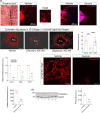Decorin suppresses tumor lymphangiogenesis: A mechanism to curtail cancer progression
- PMID: 38652741
- PMCID: PMC11067011
- DOI: 10.1073/pnas.2317760121
Decorin suppresses tumor lymphangiogenesis: A mechanism to curtail cancer progression
Abstract
The complex interplay between malignant cells and the cellular and molecular components of the tumor stroma is a key aspect of cancer growth and development. These tumor-host interactions are often affected by soluble bioactive molecules such as proteoglycans. Decorin, an archetypical small leucine-rich proteoglycan primarily expressed by stromal cells, affects cancer growth in its soluble form by interacting with several receptor tyrosine kinases (RTK). Overall, decorin leads to a context-dependent and protracted cessation of oncogenic RTK activity by attenuating their ability to drive a prosurvival program and to sustain a proangiogenic network. Through an unbiased transcriptomic analysis using deep RNAseq, we identified that decorin down-regulated a cluster of tumor-associated genes involved in lymphatic vessel (LV) development when systemically delivered to mice harboring breast carcinoma allografts. We found that Lyve1 and Podoplanin, two established markers of LVs, were markedly suppressed at both the mRNA and protein levels, and this suppression correlated with a significant reduction in tumor LVs. We further identified that soluble decorin, but not its homologous proteoglycan biglycan, inhibited LV sprouting in an ex vivo 3D model of lymphangiogenesis. Mechanistically, we found that decorin interacted with vascular endothelial growth factor receptor 3 (VEGFR3), the main lymphatic RTK, and its activity was required for the decorin-mediated block of lymphangiogenesis. Finally, we identified that Lyve1 was in part degraded via decorin-evoked autophagy in a nutrient- and energy-independent manner. These findings implicate decorin as a biological factor with antilymphangiogenic activity and provide a potential therapeutic agent for curtailing breast cancer growth and metastasis.
Keywords: VEGFR3; breast cancer; ex vivo lymphatic ring assay; lymphatic vessels; small leucine-rich proteoglycan.
Conflict of interest statement
Competing interests statement:The authors declare no competing interest.
Figures






Update of
-
Decorin suppresses tumor lymphangiogenesis: A mechanism to curtail cancer progression.bioRxiv [Preprint]. 2023 Aug 29:2023.08.28.555187. doi: 10.1101/2023.08.28.555187. bioRxiv. 2023. Update in: Proc Natl Acad Sci U S A. 2024 Apr 30;121(18):e2317760121. doi: 10.1073/pnas.2317760121. PMID: 37693608 Free PMC article. Updated. Preprint.
References
-
- Escobedo N., Oliver G., Lymphangiogenesis: Origin, specification, and cell fate determination. Annu. Rev. Cell Dev. Biol 32, 677–691 (2016). - PubMed
-
- Jalkanen S., Salmi M., Lymphatic endothelial cells of the lymph node. Nat. Rev. Immunol. 20, 566–578 (2020). - PubMed
-
- Royston D., Jackson D. G., Mechanisms of lymphatic metastasis in human colorectal adenocarcinoma. J. Pathol. 217, 608–619 (2009). - PubMed
Publication types
MeSH terms
Substances
Grants and funding
LinkOut - more resources
Full Text Sources
Miscellaneous

